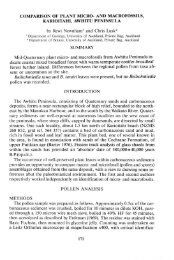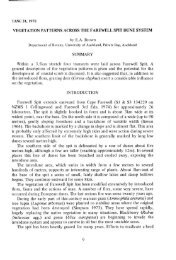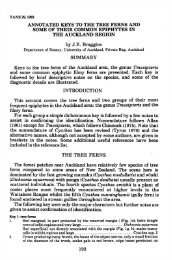aspects of fish biology form and function
aspects of fish biology form and function
aspects of fish biology form and function
Create successful ePaper yourself
Turn your PDF publications into a flip-book with our unique Google optimized e-Paper software.
304a<br />
noticeably slippery, whereas several midwater swimming <strong>fish</strong> do not produce<br />
mucous <strong>and</strong> are rough <strong>and</strong> s<strong>and</strong>papery to feel (e.g. slender roughy,<br />
Hoplostethus elongatus, <strong>and</strong> pink rnaomao, Caprodon longimanus) .<br />
Spines are usually associated with protection. They are found in<br />
the fins, especially the dorsal fin, on the opercular <strong>and</strong> preopercular<br />
bones (e.g. the redb<strong>and</strong>ed perch, Ellerkeldia huntii, <strong>and</strong> the two-spot<br />
demoiselle, Chromis dipilus) , on the tail (e.g. the stingrays <strong>and</strong> eagle<br />
rays) or all over the body (e.g. the porcupine <strong>fish</strong>, Allomyctevus<br />
whitleyi) The effectiveness <strong>of</strong> their protection is greatly increased<br />
by the association <strong>of</strong> poison gl<strong>and</strong>s with the spines , as in the rays <strong>and</strong><br />
red scorpion<strong>fish</strong> (Scorpaena cardinalis) .<br />
The senses<br />
Fish possess the senses <strong>of</strong> smell, touch, taste, sight,<br />
<strong>and</strong> electroreception. The.degree <strong>of</strong> development <strong>of</strong> the sense<br />
<strong>and</strong> associated- structures is <strong>of</strong>ten related to the <strong>fish</strong> ! s mode <strong>of</strong> life<br />
or habitat.<br />
SMELL:<br />
The olfactory organs in <strong>fish</strong>es, the nostrils, are essentially a<br />
deep pit lined with sensory tissue. Most <strong>fish</strong> have two pair, one<br />
situated on each side <strong>of</strong> the snout, excluding the pomacentrids which<br />
usually have only one set <strong>of</strong> nostrils. The nostrils are never used for<br />
breathing in <strong>fish</strong>es as they are in the terrestrial vertebrates. The<br />
sense <strong>of</strong> smell plays <strong>and</strong> important part in finding food in some species,<br />
especially the sharks which have poor sight.<br />
TOUCH:<br />
Cells sensitive to touch are found all over the body. Some <strong>fish</strong><br />
may also have special feelers to aid in the search for food, for<br />
example the elongated lower pectoral fin rays <strong>of</strong> the porae (Cheilodaotylus<br />
douglasi) <strong>and</strong> the red gurnard (Chelodonichthys kurrru) .<br />
SIGHT:<br />
hearing<br />
organs<br />
Fish eyes are very like our own in that there is a sensitive screen<br />
(the retina) at the back <strong>of</strong> the eye <strong>and</strong> a lens which projects an image<br />
onto that screen. However, unlike the human eye the iris does not exp<strong>and</strong>










